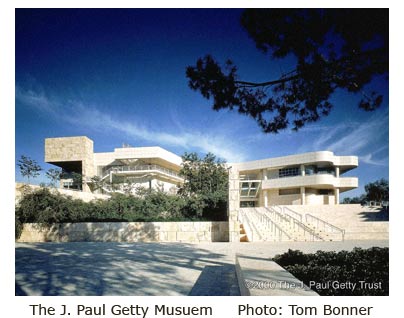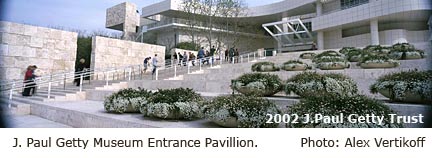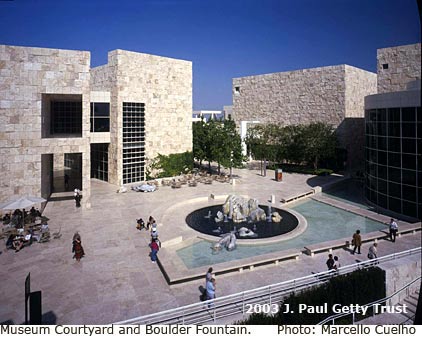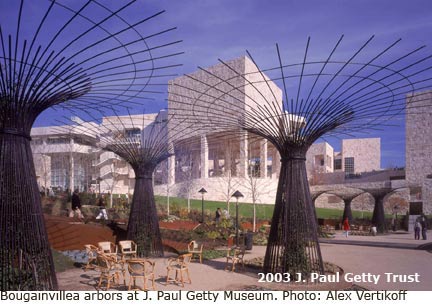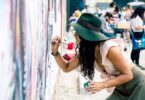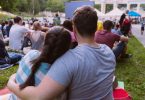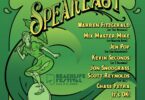Los Angeles has no culture…" You can’t have an intelligent conversation here to save your life…" It’s just surface and no substance…" You’ve heard it all before from strangers, visitors, and even well-meaning friends, and frankly, you’re sick of it. Next time, instead of trying to defend your home, take your favorite naysayer to the Getty Center – then watch their preconceptions fall away.
Rising above the Los Angeles basin, the Getty Center is a familiar sight to anyone who’s driven (or more likely, been stuck on) the 405. From a distance, the sprawling property beckons like a modern castle far beyond the realm of any mere mortal. On the contrary, the Getty Center is not only open to the general public, it’s free. Just pay the $7 parking fee and ride the tram to the top, and you have the makings of a memorable and affordable day out.
Designed by noted architect Richard Meier, the Getty Center occupies 24 acres atop the Santa Monica hills, and on a clear day, museum visitors can enjoy a spectacular view stretching from the Pacific Ocean to Big Bear. In its entirety, the campus includes the J. Paul Getty Trust’s educational, research, and conservation arms, but it’s the Getty Museum and Robert Irwin’s stunning Central Garden that most visitors will see.
The legacy of the late oil billionaire J. Paul Getty, the museum opened its doors to the public in 1997, after eight years and $1 billion of construction, with the goal of compiling a distinguished collection and bringing the high arts to a diverse audience. The Getty Museum entered the scene in a flurry of publicity, with reservations booked for a solid four months. Though it’s a lot easier to get into the museum these days, it still draws art appreciators from around the world. Nearly a decade after its debut, it’s hard to imagine Los Angeles without it.
The collection is housed in the museum’s four pavilions, and in accordance with the wishes of Getty himself, there is little 20th- and 21st-century art besides photography. Nonetheless, visitors can lose themselves in the museum’s vast selection of European paintings, drawings, illuminated manuscripts, decorative arts, and ancient sculpture.
This stylistic emphasis can be seen in the two current exhibits devoted to Flemish artist Peter Paul Rubens. One show presents the largest group of joint works by Rubens and Jan Brueghel the Elder. Even in 17th-century Netherlands, when collaborations between two or more artists were common, Rubens and Brueghel forged an unusual system. Rubens and Brueghel: A Working Friendship examines these two masters’ distinctive styles, their influence on each other, and the resulting compositions.
The second exhibit, Ruben and His Printmakers, explores Ruben’s methods for reproducing and dispersing his work, at a time when creating even a reproduction was an arduous task. As with his Brueghel partnership, Rubens’s working relationships with his printmakers bolstered his reputation, while providing guidance to his charges.
Elsewhere at the Getty, the museum features the work of photographer Eliot Porter, an early supporter of color photography and its usefulness in framing the natural world. You can also view exhibits on the emergence of landscape as a representational object, the Italian Futurists, and the Trust’s renowned assemblage of antiquities. In addition to its artistic offerings, the Getty Museum presents an ongoing program of live music, lectures, and family activities.
Speaking of families, the Getty is the perfect getaway for your whole clan. With movie tickets costing more than $10 per person and amusement park prices in the stratosphere, the Getty is beyond affordable–it’s practically a blessing. Best of all, your family won’t know that it’s good for them, while your friends won’t want to admit that you were right all along.
The Getty Center
1200 Getty Center Drive
Los Angeles, CA 90049?1679
The Getty Center Tours and Gallery Talks:
Garden Tour
Daily through June 30, 2007
11:30 am, 12:30 pm, 2:30 pm, 3:30 pm
Central Garden, Getty Center
This is a 45-minute tour of the Getty gardens, including Robert Irwin’s Central Garden. Meet the docent outside at the bench under the sycamore trees near the front entrance of the Museum.
Rubens and Brueghel Exhibition Tour
Daily through September 24, 2006
1:30 pm
Exhibitions Pavilion, Getty Center
A special one-hour exhibition overview of Rubens and Brueghel: A Working Friendship. Meet at the Museum Information Desk.
Focus Tour: Looking Toward Modern Art
Saturdays through November 18, 2006
3 pm
Museum Galleries, Getty Center
Enjoy a one-hour tour that focuses on the origins of modern art in the late 1800s and explores how artists rejected traditional rules of representation to develop new forms of art. Meet at the Museum Information Desk.
Exhibitions:
Eliot Porter: In the Realm of Nature
Daily through September 17, 2006
West Pavilion, Plaza Level, Getty Center
Eliot Porter (American, 1901-1990) is known for his detailed and exquisite photographs of birds and landscapes. Porter promoted the use of color materials at a time when most serious photographers worked in black-and-white. An artist of uncommon perception, his artistic and technical contributions to bird and landscape photography transformed these genres. This exhibition includes a selection of Porter’s early black-and-white landscape photographs, later color landscapes, and bird photographs made over the course of his career.
Rubens and Brueghel: A Working Friendship
Daily through September 24, 2006
Exhibitions Pavilion, Getty Center
Between about 1598 and 1625, Antwerp’s most eminent painters, Peter Paul Rubens and Jan Brueghel the Elder, jointly produced sophisticated, beautiful works that transformed the Flemish tradition of painting. Exploring their long, close friendship and fruitful partnership, this exhibition assembles?for the first time?more than a dozen of their collaborations together with important coproductions made with their Flemish contemporaries. The exhibition draws on the expertise of paintings conservators whose technical examination of the Getty Museum’s painting Return from War: Mars Disarmed by Venus, among other works, has unearthed new information regarding this illustrious artistic partnership. Co-organized by the Getty Museum and the Royal Picture Gallery Mauritshuis, The Hague, the exhibition travels to the Mauritshuis after its showing at the Getty.
Rubens and His Printmakers
Daily through September 24, 2006
East Pavilion, Plaza Level, Getty Center
Peter Paul Rubens employed a small army of artists to make prints after his most successful paintings, drawings, and tapestry designs, thus increasing his fame throughout Europe. This exhibition explores the close working relationship between Rubens and his printmakers, elucidating a fascinating aspect of artistic collaboration. Not satisfied with making mere reproductions of his pictures, Rubens encouraged his artists to modify his compositions, which he also often reworked. In attempting to meet Rubens’ strict demands, his printmakers contributed significantly to the development of Western printmaking techniques. The display’s key theme of collaboration offers a supporting dialogue to the exhibition Rubens and Brueghel: A Working Friendship.
A Renaissance Cabinet Rediscovered
Daily through December 28, 2008
South Pavilion, Plaza Level, Getty Center
This exhibition traces the study of one Getty object to determine its date and place of manufacture. The cabinet, acquired in 1971, had since the 1980s been believed to be a pastiche if not an outright fake. However, documentary research and technical analysis undertaken by experts at the Getty revealed that the cabinet, rather than being a compromised object, is one of the most important pieces of French Renaissance furniture in the United States. This case study of the research into the authenticity of the cabinet presents the results of scientific and visual analyses of the object, studies of related materials, archival research, and other evidence. It is a story of how new information, careful research, and evolving analytic processes can alter our understanding of the art of the past.
Classical Connections: The Enduring Influence of Greek and Roman Art
Daily through December 31, 2008
North Pavilion, Plaza Level, Getty Center
This installation of antiquities demonstrates the relationship of ancient art to later work, showing some of the themes, techniques, and motifs borrowed by later artists from mythology to decorative design and the approach to the human figure known today as the classical ideal. This permanent collection installation is on view in the North Pavilion.
Casting Nature: Fran?ois-Thomas Germain’s Machine d’Argent
Daily through March 25, 2007
North Pavilion, Plaza Level, Getty Center
This exhibition highlights the recent acquisition of a unique silver sculpture, La Machine d’Argent (1754), made by the French royal silversmith Fransois-Thomas Germain (1726?1791). In the tradition of trophies of the hunt, the piece represents an assemblage of two game birds, a rabbit, and vegetables. The exhibition places the significance, beauty, and naturalistic virtuosity of La Machine d’Argent within the context of French mid-18th-century art, as illustrated through select loans of paintings and prints along with other works in silver and gilt bronze in the Getty Museum’s collection.
Landscape in the Renaissance
Daily through October 15, 2006
North Pavilion, Plaza Level, Getty Center
The Renaissance witnessed a renewed awareness of the visible world and a pressing need to describe natural phenomena"rain, atmosphere, and the play of light" faithfully and with conviction. This exhibition explores the rapid and exciting development of landscape settings in art of the Renaissance, especially through examples in the Getty Museum’s collection of illuminated manuscripts.
A Tumultuous Assembly: Visual Poems of the Italian Futurists
Daily through January 7, 2007
Research Institute Exhibition Gallery, Getty Center
In a manifesto of 1912, the Italian Futurists advocated the destruction of poetic convention and linguistic logic in the creation of a new literary genre that was both visual and verbal: the parole in libert? (words-in-freedom). These visual poems deployed explosive language, inventive typography, and unorthodox design to evoke the modern experience of speeding trains, airplanes, factories, bombs, and the urban cafe. This exhibition of manuscripts, drawings, rare books, and journals from the special collections of the Research Library at the Getty Research Institute features various experiments in the genre, including BIF&ZF+18 by Ardengno Soffici, "Fabbrica + Treno" by Angelo Rognoni, and Zang Tumb Tumb by F.T. Marinetti, leader of the Italian Futurist movement. The poems range in theme from the battlefields of World War I to the everyday life of the Futurist artist-poet and are analyzed in terms of their political context and technical characteristics.


